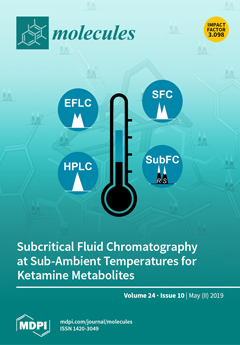Utilizing bioassay- and TLC-guided column chromatography, fifteen secondary metabolites from
Populus alba and eight compounds from
Salix subserrata were isolated, including a novel plant metabolite salicyl ether and characterized using ultralviolet light (UV) absorbance, mass spectrometry (MS),
1H-,
13C-NMR (nuclear magnetic
[...] Read more.
Utilizing bioassay- and TLC-guided column chromatography, fifteen secondary metabolites from
Populus alba and eight compounds from
Salix subserrata were isolated, including a novel plant metabolite salicyl ether and characterized using ultralviolet light (UV) absorbance, mass spectrometry (MS),
1H-,
13C-NMR (nuclear magnetic resonance), heteronuclear single quantum coherence spectroscopy (HSQC) and heteronuclear multiple bond correlation (HMBC). The extracts, their sub-fractions and the isolated compounds exhibited promising antioxidant activities in vitro in DPPH and FRAP assays. Also, the extracts of
P. alba leaf (PL), shoots (PS), and
S. subserrata leaf (SL) demonstrated substantial antioxidant activities in vivo in the multicellular model organism
Caenorhabditis elegans. For the first time, the isolated secondary metabolites, aromadendrin, tremuloidin, salicin, isorhamnetin-3-
O-β-
d-rutinoside, gallocatechin, triandrin, and chrysoeriol-7-
O-glucuronide were investigated. They exhibited substantial antioxidant activities in vivo. Salicin, isorhamnetin-3-
O-β-
d-rutinoside and gallocatechin, in particular, protected the worms against a lethal dose of the pro-oxidant juglone (80 µM), decreased the endogenous reactive oxygen species (ROS) level to 45.34%, 47.31%, 68.09% and reduced juglone- induced hsp-16.2::GFP (green fluorescence protein) expression to 79.62%, 70.17%, 26.77%, respectively. However, only gallocatechin induced higher levels of sod-3 expression. These findings support the traditional use of
Populus alba and
Salix subserrata for treating inflammation especially when ROS are involved.
Full article






